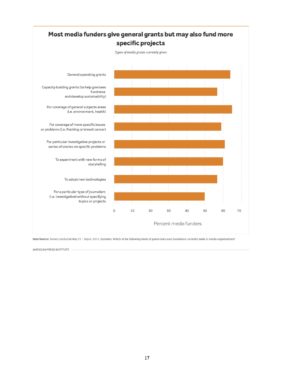
In a recent episode of Current‘s podcast “The Pub,” host Adam Ragusea called the implications of the American Press Institute’s recent report on the ethics of foundation-supported journalism “horrifying.” Are nearly half of funders investing in journalism only doing so to advance narrow policy goals?
On closer read, Ragusea’s hot take on the topic not only ignores a fair bit of nuance in the report itself, but misses another piece of the story entirely. Namely, that more foundations than ever are willing to support journalism that addresses social issues head-on and dig deeply into corporate and political corruption.
Of course, the report’s authors—Tom Rosenstiel, William Buzenberg, Marjorie Connelly and Kevin Loker—correctly call out funders who breach journalistic independence by demanding to review stories before publication, or stipulating that reporters toe a party line on an issue. By treating journalism as if it’s PR or strategic communications, funders can undercut audience members’ trust and damage the brand of the outlet they’re supporting. In the same way that firewalls have previously been set up to ward off undue influence from government, owners and advertisers, outlets need policies to guard against pressure from foundations and individual donors.
The API researchers found that only 4 in 10 of the nonprofit news organizations surveyed have written guidelines about the funding they’ll accept, and only 10 percent of the funders surveyed require grantees to provide guidelines detailing their editorial independence. By identifying this gap, they make a valuable contribution to the field of nonprofit journalism.
They also found that more foundations are funding nonprofit news organizations, and are spending more money on media than they have before. This should be great news for a struggling field.
However, by too narrowly defining both journalists and funders and by adopting a defensive posture that artificially pits pure-minded journalists against agenda-driven funders, the report’s authors risk driving away a valuable and rising source of support.
Journalism is not monolithic
The fact that funders can play a key role in propping up a field in crisis is not lost on the report’s authors. “There is ample evidence that nonprofit funding of news has helped journalism,” they write.
Charitable donations have spawned important work by outlets such as ProPublica, The Center for Investigative Reporting and The Center for Public Integrity (one of this report’s co-authors, Bill Buzenberg, is the former executive director of that organization). Nonprofit funding has subsidized creative and bold experiments in new and niche media by innovators such as InsideClimate News, Chalkbeat, and the The Marshall Project. It has helped create new robust local coverage by entrants such as The Texas Tribune, MinnPost and Voice of San Diego. It has forged new partnerships with commercial news outlets, who have embraced collaborations they once might have shunned.
However, like many journalism reports before it, this litany of model nonprofit outlets ignores many venerable journalism organizations that have been navigating the terrain of nonprofit news for decades and could bring wisdom to this discussion. These include political magazines such as Mother Jones and educational magazines such as National Geographic (which recently made the switch from nonprofit to for-profit when acquired by Rupert Murdoch’s 21st Century Fox—an ethics conversation for another day).
The report’s title—Charting new ground: The ethical terrain of nonprofit journalism—signals that these outlets are outside the pale. It also ignores the strong overlap between journalism and documentary, a gap that has been closing with foundation support as both communities of makers grapple with producing stories for new platforms.
Even the way the report’s authors define journalism sets limits on what constitutes acceptable practice in their eyes: “Journalists usually see themselves in the business of making information public—though some of their work can be described as close to advocacy when they function as watchdog or investigator exposing wrongdoing.”
“Making information public” is a pretty wan definition of journalism’s core mission by any standard—and even calling out watchdog or investigative journalism doesn’t cover the whole field of practice. Journalism serves many different roles in local communities and in the larger society: informing, convening, providing platforms for debate, explaining complex topics, reflecting the culture back to itself, inspiring audiences, and much more.
 This is not a new debate. In 2013, the Columbia Journalism Review dedicated an entire issue to the question “What is journalism for?” Answers ranged from “an activity, not a profession,” to “the immune system of democracy.” Given this broad range of definitions across the profession, crafting a rigid code of ethics based on a limited definition and trying to apply it across the varied field of nonprofit news is bound to generate resistance.
This is not a new debate. In 2013, the Columbia Journalism Review dedicated an entire issue to the question “What is journalism for?” Answers ranged from “an activity, not a profession,” to “the immune system of democracy.” Given this broad range of definitions across the profession, crafting a rigid code of ethics based on a limited definition and trying to apply it across the varied field of nonprofit news is bound to generate resistance.
Funders are not monolithic
The authors also hone in on a particular power relationship between organizations and funders—attempts by funders to shape coverage.
Again, this is a serious issue that deserves attention, and more work needs to be done to educate both funders and journalists who are new to the field of nonprofit media.
Among the 94 nonprofit outlets that responded to the survey, nearly three-quarters are less than 10 years old, and 35 percent started up within the last five years. And while the foundations themselves skew older—two-thirds of those surveyed have been operating for more than 15 years, and nearly 30 percent for 50 years or more—an influx of new media funding from foundations suggests that at least in some cases fresh staff members are being hired to administer these funds. A crash course in journalism history may be needed on both sides of this equation.
At the same time, as the report suggests, many funders are actually not supporting journalism in order to meet advocacy goals.
Of the 63 foundations that responded to the survey and answered “yes” to the question: “Does your foundation make grants to news or media organizations?,” 43 percent said the share of their overall giving to media projects had increased in the past five years, and 41 percent said the number of media grants had grown during this time. They report that their media grants span various goals, only some which relate to funding for specific subjects, issues or investigative projects. Other goals include supporting general operations, capacity building, adoption of new technologies and experimentation with new forms of storytelling.

This mirrors our own findings from a 2015 report, that funders approach the challenge of media funding from a variety of perspectives, and even define advocacy goals in a range of ways. It’s worth remembering that not all media funding is journalism funding. Foundations also support strategic campaigns, photography, games and other forms that don’t hew to journalism’s traditional standards of objectivity. They also don’t always fund to advance a particular policy perspective — but rather to better understand a range of perspectives, or to support additional debate on an issue.
For the most part, even the most contested forms of support do not present a problem. “The [API] report finds relatively high levels of transparency about funding sources and what is being underwritten,” write the authors. “There is little evidence that funders insist on or have any editorial review. Most never see content prior to publication.”
In other words, a few bad actors are spoiling the equation—and fear of such influence is sparking responses that threaten to drive dollars away from the nonprofit news sector altogether. In a companion essay, Dan Green of the Gates Foundation underscores this point:
I worry that philanthropic funding of media could go in a couple of undesirable directions: Funders could decide to avoid media funding entirely because critics might charge them with tainting independent media. Or, with publishers more willing to sell native advertising and sponsored content, donors could push to fund more targeted, message-aligned content that could irreparably damage the credibility of both organizations. I believe there is a middle ground in which funding can be framed within certain respected guidelines and best practices. Grant-making does not have to exist at the extremes — either general operating support or nothing.
Impact is not monolithic
As is often the case, the conversation around advocacy and ethics is integrally connected to the question of impact metrics.
“I wonder sometimes ..if donors [are] the most corrupting form of money that we have in the system,” Ragusea said to Rosenstiel, “Because these organizations expect to get something for what they’re giving…We generally don’t think about outcomes with journalism. In fact, we try not to think about outcomes with journalism. We just put it out there and it does what it does in the world or it doesn’t do what it does in the world.”
Rather than attending to funders’ interest in whether coverage has changed reader awareness or public policy, “for a journalist, Rosenstiel replied, “impact would be you did another story, that there was enough of a resonance that you pushed the conversation, that there needed to be more conversation. And that’s very incremental, but that’s the way that journalists think about it. The idea that you’re going to change a law, that could be five, six, seven years in the making, and there’s a great deal of journalism that journalists think is necessary, vital, that has nothing to do with ever changing laws….journalists need to actually start inventing metrics that they think are reasonable for them.”
There’s still space for journalists to do this—not only in opposition to funders, but in conversation with them. Given how volatile the marketplace for journalism continues to be, the opportunity is wide open for outlets to rewrite the legacy contracts with advertisers, audiences and donors in ways that make news more interesting, inclusive, and dare we say it, impactful.
Thinking this way—in terms of negotiating flexible contracts rather than navigating inflexible codes—is not new. A report we jointly released with the Media Impact Project last June lays out a range of different types of impact that funders and newsrooms might measure. It also offers a tip of the hat to Active Voice for developing the concept of “pre-nups” for funders and media makers, along with sample questions that help to clarify the point of the project and of the evaluation itself.
Being armed with an array of such questions can help outlets communicate with funders from a position of strength, and draw clearer lines when it comes to influence and review.
And—hopefully—it can help to make such conversations just a little less horrifying.
